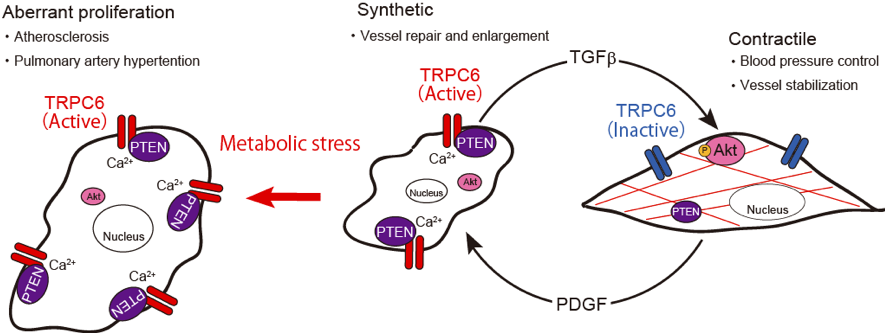Vascular smooth muscle cells (VSMCs) play critical roles in the stability and tonic regulation of vascular homeostasis. VSMCs can switch back and forth between highly proliferative synthetic and fully differentiated contractile phenotypes in response to changes in the vessel environment. Although abnormal phenotypic switching of VSMCs is a hallmark of vascular disorders such as atherosclerosis and restenosis after angioplasty, how control of VSMC phenotypic switching is dysregulated in pathological conditions remains obscure. We found that inhibition of canonical transient receptor potential 6 (TRPC6) channels facilitated contractile differentiation of VSMCs through plasma membrane hyperpolarization. TRPC6-deficient VSMCs exhibited more polarized resting membrane potentials and higher Akt activity than wild-type VSMCs in response to transforming growth factor β1 (TGFβ1) stimulation. Ischemic stress elicited by oxygen/glucose deprivation suppressed TGFβ1-induced hyperpolarization and VSMC differentiation, but this effect was abolished by TRPC6 deletion. TRPC6-mediated Ca2+ influx and depolarization coordinately promoted the interaction of TRPC6 with lipid phosphatase PTEN, a negative regulator of Akt activation. Given the marked upregulation of TRPC6 observed in vascular disorders, our findings suggest that attenuation of TRPC6 channel activity in pathological VSMCs could be a rational strategy to maintain vascular quality control by fine-tuning of VSMC phenotypic switching.

Activation of TRPC6 plays a critical role in the determination of VSMC phenotype. Once VSMCs are exposed to metabolic stresses, TRPC6 channel activity is increased and TRPC6-mediated cation influx suppresses the VSMC switching from synthetic to contractile phenotype. This may be the major cause of atherosclerosis or pulmonary artery hypertension, and inhibition of TRPC6 channel activity in VSMCs will be a new therapeutic strategy.
Journal article
Title: TRPC6 regulates phenotype switching of vascular smooth muscle cells through plasma membrane potential-dependent coupling with PTEN.
Authors: Numaga-Tomita, T., Shimauchi, T., Oda, S., Tanaka, T., Nishiyama, K., Nishimura, A., Birnbaumer, L., Mori, Y., and Nishida, M.
Journal: The FASEB Journal
Date: 2019 Jun 4.
URL: https://www.fasebj.org/doi/abs/10.1096/fj.201802811R
DOI: 10.1096/fj.201802811R.
Collaborative Researcher
Name: Takuro Numaga-Tomita
Department: Department of Molecular Pharmacology
Institute: Shinshu University, Graduate School of Medical Sciences
Name: Lutz Birnbaumer
Department: School of Medical Sciences
Institute: Catholic University of Argentina, Institute of Biomedical Research
Name: Yasuo Mori
Department: Department of Synthetic Chemistry and Biological Chemistry
Institute: Kyoto University, Graduate School of Engineering
Funding
This research was funded by grants from JSPS KAKENHI Nos. 16H05092 and 19H03383 (to M.N.), and No. 17K15585 (to T. N-T.); Scientific Research on Innovative Areas (Research in a Proposed Research Area No. 15K21759 ‘Oxygen Biology’ to Y.M. and M.N., and 18H04993 ‘Living in Space’ to T. N-T.) from the Ministry of Education, Culture, Sports, Science, and Technology of Japan. This work was also supported by the Cooperative Study Program of National Institute for Physiological Sciences and Spectrography and Bioimaging Facility, NIBB Core Research Facilities, and Ono Medical Research Foundation and the Naito Foundation.

